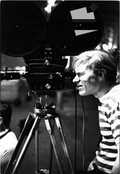The Vincent Fremont Interview
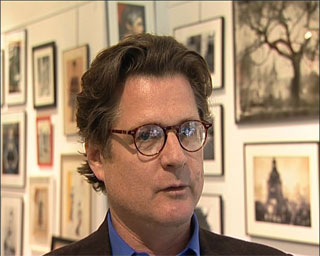
Vincent Fremont in "Andy Warhol's Factory People"
What were Andy’s major painting series before and during the Silver Factory era?
Andy’s painting... the output that he did between the Fire House and The Silver Factory is what most people know of his work.
The Flower Paintings, the Electric Chair, the Death and Disaster Paintings. The very powerful work that still I think is just as powerful now, still affects people. The Race Riot Paintings. Those were all done before he got to Union Square West. But like every artist his name was made in 1962 with the Cambell’s Soup Cans.
Then, he became a notoriety with the Elvis paintings. So you have this great body of work he produced. Like people think, “Oh, he got shot and now he can’t do anything anymore, he doesn’t want any crazy people around.”. Well, they were just a different kind of crazy people. They looked different...they were dressed differently... that was the beginning... where the drag queens and transvestites started coming to visit Andy.
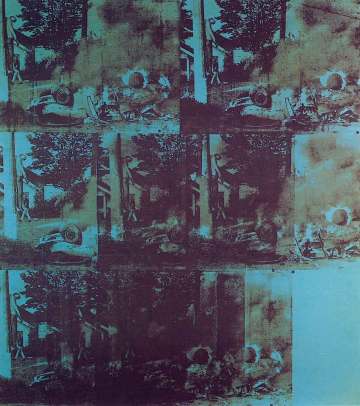
Andy Warhol's Green Burning Car, from the Death and Destruction Series.
What was the nature of the work that Andy was doing at that period of time. What were some of the influences...?
What were Andy’s influences? Again, if I was there I could tell you, but I know that he kept files of let’s say the suicide photographs. AP photgraphs of car accidents. He was very methodical. He was a great editor. So, I think that death or the subject of death starts very early on in his work. The Jackies’s, the Marilyns’s, you see it all progresses. And these were all done in the Siver Factory period, basically...with the exception of the Elvis’s which started in the Fire House.
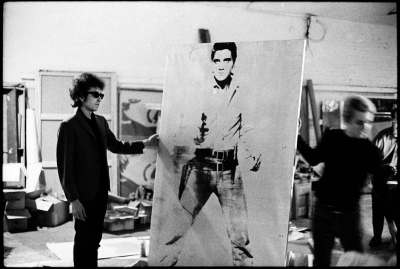
Andy gave Bob Dylan an Elvis, he traded it for a piece of furniture!
Why was his imagry selective?
He was a great editor. He knew how to pick. He didn’t just pick any photograph. He didn’t pick just any subject. They seemed to always resonate, and they continue to resonate. He was a genuinely true visionary. He really understood media...he understood what people, icons mean.
He was a great fan as a child of movie stars but he sees it in a different way than most of us. That’s what distinguishes him from anybody else. That’s what distinguishes any artist who’s talented and has a vision. They see the world differently, and Andy was born at the right time and at the right place to be this person to guide us into where we are right now. Where the media has taken over. But he saw it forty years ago! So, I think that all that intensity that was going on, fueled by lots of party and I’m sure there was a lot of amphetamine running around. People were taking lots. Andy never really overdid. It was almost legal in a sense. You could use it for losing weight. But the craziness also energized everybody.
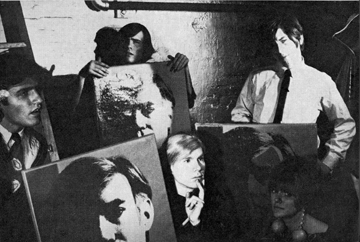
What was Andy’s work ethic?
Andy was a workaholic. In the 50’s he was making a lot of money as a commercial artist. Never underestimate Andy.... Andy was never like, “ Oh, I’m not doing anything”. He was working all the time. Producing to pay the bills, and, you know, he was a successful person.
He was always a fine artist. You look at his sketch books in the fifties, they are fantastic. The world trip that he did in 1956. So, he took his time,
He could be put down very easily because he was coming from the commercial side. Well, that still does not make you not an artist. He developed the blotted line and took it to another level of print making. He was an innovator.
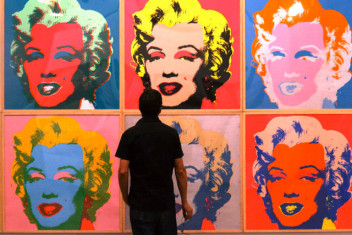
Think Zen repitition.
Some of the people I have spoken with have told me that they can remember instances where they would be with Andy, and Andy would say “Oh..I just don’t know what to do next...I don’t know what to do.”. And my take on that is just that that was Andy talking. Andy knew absolutely what he wanted to do. Agree?
That’s his way of getting his mind to be thinking. He did take ideas from people in the way of editing things. He’d ask a number of people what he should do, and everybody thought that what they said, he would do. So he would edit it out...filter it. It was a filtering process. It’s almost like going through a magazine with images. It’ almost the same thing. When somebody starts talking he’s maybe going to take something of that, something of this, and he was a master at that, but he ultimately made the final decision.
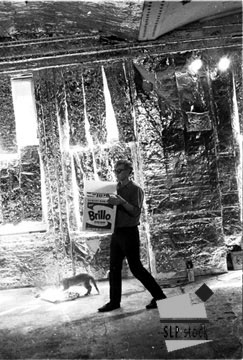
Andy with Brillo and Billy's cat Ruby.
Suggestions that Andy picked up on…?
There are very famous incidences in the 60’s where Ivan Karp said something to him…“Paint your favorite thing, it’s money!” So he did the dollar bills. I can’t really remember who said that but these are things he would pick up on.
Andy worked it?
He didn’t just take an idea, he worked it for himself. People threw out ideas all the time and they were just not used...not used; but if something came up and he could move it around.

Valerie Solanis shot Andy in the Spring of 1968, formally ending the "Silver Factory Period".
So Andy was accessable…?
It got very dangerous when it almost took his life. Then he changed a bit, in that sense, about who could get close to him. That kind of changed. He was still very accessible but the craziness he always was attracted to, in a certain sense, it equated with creativity. Because the minds are always working.
Lots of crazy people will always talk, talk, talk... and in that talk there is some brilliance that comes in and out and shimmers in and out of it. But it can be very dangerous.
He was very good at being with people who were not quite...not thinking in the same way most people thought, because... he thought in an entirely different way.
Andy, always thinking!
How did Andy think?
His pattern of thinking was....you never knew what he would be thinking or saying next. People always said they did, but you didn’t really.
Was he dyslexic?
Whether he was dyslexic...people would say. I have no idea. They would say, he couldn’t read, or didn’t read. But he always had books and he was up on every topic. (Peopole say that) he didn’t know how to draw. But well tell me. I’ve seen the drawings. They’re incredible. So he played games and had a great sense of humor. He was very facile with the ideas.
Did Andy build a myth around himself?
He did, and with the help of the press, he built a myth because they believed everything he said. They didn’t realize he was full of irony and humor. And then writers get lazy, so the journalists start reading each others’ work.
How did Andy handle the media?
Andy was the master of handling the media. Over time, a lot of the journalists that interviewed him believed everything he said. They neglected to understand his sense of irony, his sense of humor, and they took everything verbatum.
So he played them, even giving them the wrong date of birth, the place of birth. It actually took them up until he died to figure it out!
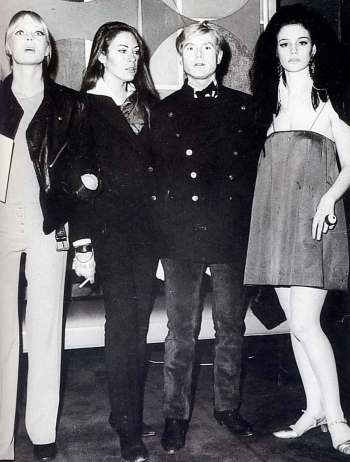
Always getting good press. Out with Nico, Mary and Susan.
Was Andy a “good interview”?
He was a very good interview because he didn’t say very much and they could just put anything they wanted, but they started reading each others articles and pretty soon that myth starts up because (it’s) based on no fact. So its kind of this geometrical formation that starts up... each one reading the other one, and another one. And every once in a while there is a writer that actually gets it, and writes something intelligent and gets to who Andy is. But only for that moment....because if he came back to do it again…I mean, there are books out there that I know (where) Andy was just having a really good time and being very playful with what he is saying.
It got him in trouble sometimes. He said, at one point, ‘68ish....that “Brigitte Berlin did all his paintings”. Which was actually not true. In “Portrait of the Artist”, where this is brought up....you know very clearly, that it’s not true. Cause Brigitte is teasing him in there. It’s a great scene. But people got freaked out when they heard that. So Fred Hughes who was Andy’s business manager and great friend had to do damage control. That was one of the one times he threw something into a spin and it came back to kind of bite him a little bit.
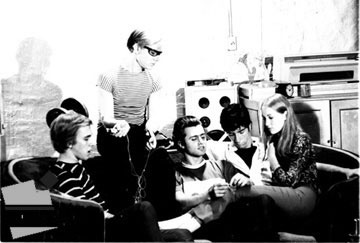
The Silver Factory "master".
They say Andy could manipulate the people around him…?
People always loved that because he was working with that. He was the Factory master ....people were doing his work. People assisted him. He revolutionized the way art is supposed to be made. He wasn’t up in a little ivory tower, painting by himself in a little studio. He was out there with people...that’s what critics hated him for, because he wasn’t acting like what artists are supposed to act like. He was wanting to make movies, he was trying...he wanted to do everything creative…everything visual.
You see, artists are visual beings. They should be allowed to do anything they want in the visual realm that makes sense and that they are good at. So Andy took the heat....coming out of history and Duchamp, and that era... the surrealists. So, he kind of just was handed the baton and he took it huge big step forward.
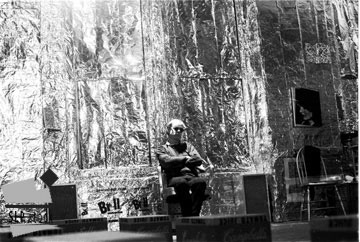
Alone in the "Silver Factory".
How did Andy influence the culture?
“Cambell’s Soup Cans...that’s not art”. I still saw this at retrospectives after he died. People would…there would be two old ladies in front of the canvas clucking and commenting and saying... well this isn’t art... the dollar bills.
So he really revolutionized and turned the world upside down... in the way... in culture. He is synonymus with the American Culture and the international culture. How he changed it.
There are certain artists that wouldn’t be working today if it wasn’t for him breaking ground.
In the same way he looked back to artists that he really appreciated and was influenced by. I think that it was a great time... in the early 60’s when the Pop Movement started because as Ivan Karp suscinctly put it, “There were all these artist living in Manhattan that didn’t know each other, and they were all on the same wave length. It was in the air.
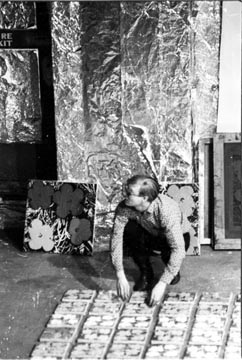
Factory Art.
This is what is so fascinating because you just mentioned everybody important of that era. Yet Andy was the most unique of all of them because he had the Factory?
Right. How dare an artist use the word “Factory” when the equation is he is making his own artwork. Andy said, “I want to be a machine. I don’t want to...”. But in reality when you make, especially at that time, his screening was done on the premises...it’s all hands on.
You have to take that squeegee, and Gerard Malanga helped him with the squeegee. He had to squeegee that ink through that silk. And you are going to get different kinds thicknesses depending on how many times you do it. It’s all very hands on. This idea of replication…Andy was fascinated with it. So, the idea that two is better than one, and that three is better than two, and so forth. So, he loved this idea of repetition. It has been written about a lot but he really was. If he was going to buy an Indian blanket, which he collected, you’d point out a chief’s blanket which was more expensive than six or eight of the lesser blankets. Andy would buy the six or eight of the lesser blankets because there was more.
More of this repetition. Cookie jars...repetition.
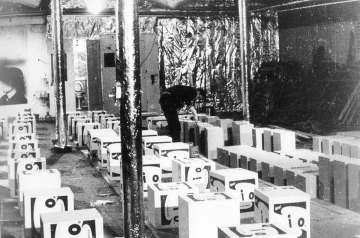
Repitition "pays".
What was the most important lesson that Andy taught?
What was the most important thing I learned from Andy? I don’t think there is just one thing.... it was multiple life lessons that if you put them together they might be one big one.
I just learned a lot of what I am doing now and I learned a lot more about Art.
He was very important. You know, just the way he approached the world. If you’re not having fun, it’s just not worth doing…as far as working...even though he was a workaholic. But he made it fun at least for himself...and everyday was not a walk in the park…there was some drudgery and things.
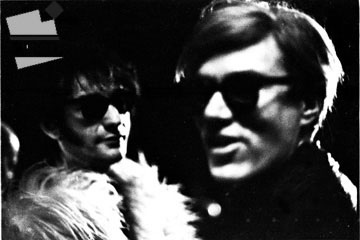
Public Andy "out on the town" with Ondine.
The public versus the private Andy?
Andy was a very powerful figure. Here was this man who supposedly didn’t speak. In public he was personified as not to talk, but in private he was a great conversationalist and gossip. He loved talking on the phone and talking to people he trusted. He had lots of close friends.
His public image was much different than his private image?
Yeah. It’s like his public image he builds. One of his artworks is himself. Andy really made this happen…from the time, starting in the 50’s...but it really culminates in the beginning of the 60’s...with the striped tee-shirts, the whole look…and the sunglasses.
He was funny. He was wearing a wig very, very long, but you know you really didn’t think about the wig. You think of his hair...or you don’t even think about it. That’s what’s extraordinary. The guy got more and more extreme, and you still didn’t think about it. Or at least I…we never talked about it until much later...maybe the last few years of his life, joking about his wig act because if he was in a convertible he’d have to hold on or it would go whoo. But he was making artwork out of it too.
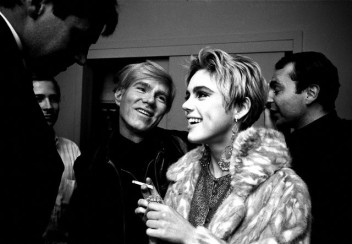
Andy and Edie.
Andy had a sense of humor…?
I think people forget that Andy had a sense of humor about the world. That’s a really good lesson. Don’t take it so seriously. And don’t take yourself too seriously. You see, he never took himself seriously. I never saw him act pompous or puffed up. That’s a life lesson right there. He had humility. He didn’t...he never thought he was good. He’d always say....I’m not as good as the rest of them...as his peers.
But he loved art and artists. Creativity, again creativity. If you were creative, that’s what he was interested in. He wasn’t interested in lazy people. If you were lounging around, that would not go well. He tested people all the time about that.
Was Andy a giver?
He gave a lot to people too. We’ve heard stories about how stingy Andy was.... he wouldn’t pay for this…but at the same time we get stories about how gracious he was...and giving, and from what I can tell he was a real giver.
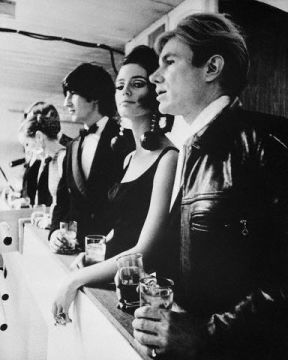
The frugal "giver" takes everybody to Cannes!
Andy has the reputation from a lot of people…for being stingy, but he was very frugal. He never threw anything away. He didn’t pay (staff) a lot... I was paid very little, but he had a work ethic. If you made money for him you made money for yourself. It was a very interesting formula. But he was…he gave a lot of artwork. Starting in the 50’s…people didn’t care at that time. But in the 70’s he gave away a lot of art, which people finally started appreciating. He was very generous in different ways.
When people think of him as stingy, he wasn’t. Don’t forget he came from a very poor background so, fear of no money was always lingering behind him at the end of every year when we had to do…getting ready to do taxes and stuff…it was “the beginning of the end”. Of course I bought into it immediately…got ready to bust. But we’d always find ways to get back up.
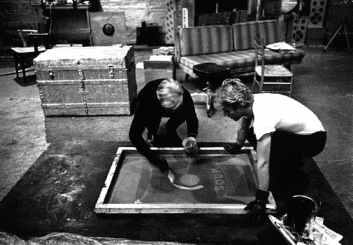
Paying the bills to keep it all going!
He really had to pay the bills. He was the central person paying the bills . He paid all our salaries. We got commissions when we sold things... so you hustled to sell interviews in magazines…you did all a number of things... and once you did that you started making money. He was, kind of in a way, my professional father.
You knew that he could trust you if he gave you more and more (to do). So you were able to do a lot of things that you would not normally have been able to do.

Vincent Fremont, VP, Andy Warhol Enterprises outside of Elaine's with the boss.
I was made vice-president of Andy Warhol Enterprises by ‘73/74…so roughly, three years after I started working with him. Of course, it didn’t make me a lot of money but I had a title. That’s when I learned about titles. They’re very cheap. But again, it was a responsibility. I started taking over aspects of the business along with Fred Hughes that he totally trusted me on. It was all most about trust.
You recently did a film about Brigid Berlin, one of the true Factory Superstars. Can you tell me about Brigid’s relationship with Andy?
Well, Brigid Berlin is a dear friend of mine and I’ve known since I first came to New York.
She’s famous for being in Andy’s “Chelsea Girls”...which embarrased her family…who was a very conservative Republican family. Her father ran the Hearst Publishing empire. So, to have a daughter who was in “Chelsea Girls”, an underground film, was quite shocking to the Park Avenue, Fifth Avenue sets that her parents frequented. J. Edgar Hoover was her father’s best friend. So, you are talking about a very conservative background.
She exchanged ideas with Andy... they were like a married couple. Brigid was the only one who could yell at him in that way...they would really torture each other in a very loving manner…but like a married couple. She always said she didn’t like his work. She’d never take a print or a painting as a present. She’d rather have a vacuum cleaner…a part in a film... anything but the artwork. I remember one time she wanted a Cartier watch. He gave her a male Cartier watch knowing that what she really wanted was a female Cartier watch...so that created a whole big Whoop-la.
Brigid was trying to lose weight, and Andy would give her a hundred dollar bill and send her over to get lots of candy and cakes at the nearest place. They would have this on-going....they talked to each other on the phone every day, every morning..
Brigitte was, of all the so-called Superstars, the one he was with the longest…until the end.
Why didn’t Andy do portraits of all his superstars?
That’s a good question. Again, that’s a matter of editing. What he wanted to do. What he was expected to have done. The photo was one form of portraiture…which he directed. But he didn’t do my portrait, he didn’t do Fred Hugh’s portrait. We never thought about it. And maybe it’s all the same thing …they were all working in front of the camera... those are in a sense, portraits. There are the “screen tests”. Eluding just to them, I don’t think he felt the need to do paintings of everybody. He was picking...he had Liz Taylor, he had these people who are icons or movie stars.
If you were making a film about the ‘60’s Silver Factory, what would you want to express..... about the people around Andy...?
Andy was the center. He was the force. He said he just was there watching and paying the rent, watching other people do things...that is again the opposite. He was the intersection that people came to. He was the light. People who came were attracted. One attracts another. He was the center. It’s like a huge magnet...of ideas and exchange of ideas; and that is what life is about, and Andy understood this. And this is what made such a success of the Silver Factory.
With all of the carrying on and the going nuts and all that, but there was a lot of creative energy at the same time. People were exchanging ideas. There were writers and there where other people coming in and out. Artists and movie stars, but Andy with his daily crew of people, they were all pretty intelligent. Some people think otherwise but I would disagree.
They all had some pretty extreme sides to them, but they were all pretty much very intelligent. They were attracted…so Andy played the village idiot. But actually he is the center. By acting blank he could suck in a lot of information. He was one of the great listeners. People forget that listening is so important. But, it was obvious to me that he was very brilliant...he just took it all in... he was very Zen.
